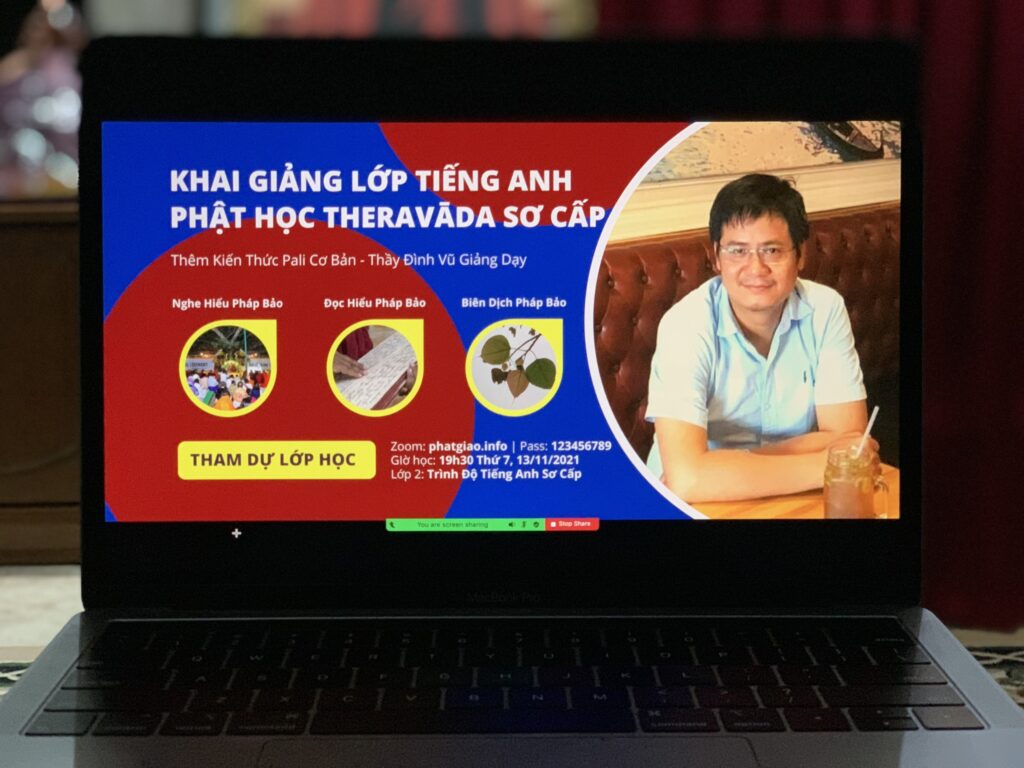Nội Dung Chính
THERAVĀDA BUDDHIST ENGLISH COURSE – KHÓA TIẾNG ANH PHẬT GIÁO THERAVĀDA CĂN BẢN
Listening, Reading Comprehension, Translation For Elementary English Level Students | Nghe hiểu, Đọc hiểu, Dịch thuật.. dành cho học viên có trình độ tiếng Anh sơ cấp
TÀI LIỆU LECTURE 1
(19:30-21:00, Saturday, November 13, 2021)
Bài giảng 1 - Lecture 1
VIDEOS LECTURE 1
Video Buổi 1: Khai Giảng Lớp Tiếng Anh Phật Học Theravada Sơ Cấp – Thầy Đình Vũ Giảng Dạy
COURSE INTRODUCTION
OBJECTIVE
o Reading Comprehension o Translation
DURATION
6 months / 24 months (Saturday, 19:30 – 21:00)
- 18 weeks: general study knowledge of Thedavāda Buddhism
- 6 weeks: practice reading and listening comprehension of Dhamma Books/Talks
METHOD OF STUDY
o Presentation o Discussion
AREAS
o Morality
o Tranquillity Meditation o Insight Meditation
o Dhamma in life
o Pāḷi
REFERENCES
o Dhamma books
o Dhamma talks (video, youtube)

QUESTIONS FOR DISCUSSION
(Câu hỏi thảo luận – 19:30-21:00, Saturday, November 13, 2021)
Please have a good preparation of following questions before the first class
(Vui lòng chuẩn bị kỹ những câu hỏi sau đây cho buổi học đầu tiên)
- Your purposes in taking this course? Mục đích của quý vị khi tham dự khóa học này?
- What do you know about the Buddha? Quý vị biết gì về Đức Phật?
- What do you know about Theravāda Buddhism? Quý vị biết gì về Phật Giáo Theravāda / Nguyên Thủy
- What do you know about Pāḷi Language? Quý vị biết gì về ngôn ngữ Pāḷi?
- What do you know about the Tipiṭaka? Quý vị biết gì về Tipiṭaka / Tam Tạng?
Buddha statue from Gupta period (c. 5th century CE), Sarnath, India (Source: wikipedia.org)
THE TEACHINGS OF BUDDHA
Cattāri Ariya Saccāni
Four Noble Truths (Tứ Diệu Đế, Bốn Sự thật Thánh thiện)
1. Dukkha Sacca: Truth of Suffering (Diệu Đế về Khổ)
2. Samudaya Sacca: Truth of the Cause of Suffering (Diệu Đế về Nguồn Gốc của Khổ)
3. Nirodha Sacca: Truth of the Cessation of Suffering (Diệu Đế về Sự Diệt Khổ)
4. Magga Sacca: Truth of the Path Leading to the Cessation of Suffering (Diệu Đế về Con Đường Diệt Khổ)
REF:
4 Noble truths: truth of Suffering, Cause of suffering, Cessation of Suffering and the Way leading to the Cessation of Suffering Over 45 years of preaching the Dhamma, the Buddha has been teaching the world nothing but these 4 truths.
1. Truth of Suffering: 3 types
– Birth, disease, aging, death, physical pain, mental distress, grief, dissociation from the beloved one, association with the undesirable things, etc. are suffering.
– Craving for the pleasure that one has experienced means suffering. (E.g.: She is used to the cold weather in Canada. Now, she stays in the Asian country. The weather here is humid and hot. Thus, she feels suffering craving for the coolness in Canada.)
– Except Nibbāna, all things in the world arise and dissolve according to its Law of Nature. We cannot control anything. We can not live forever. Thus, it is impermanence, suffering and non-soul. Being controlled in such way is suffering.
This truth covers all types of suffering in the world.
2. Truth of the Cause of Suffering
It is craving. By craving, beings are reborn again and again. And birth is again the starting point for all sufferings. (The Arahant has no more craving; therefore, he has no more suffering, i.e. no more rebirths).
There are 3 types of craving; for pleasure, for existence, and for non-existence.
3. Truth of the Cessation of Suffering
It is the extinction of suffering namely Nibbāna.
4. Truth of the Path Leading to the Cessation of Suffering
This means the 8-fold path including: Right Understanding, Right Thought, Right Speech, Right Action, Right Livelihood, Right Effort, Right Mindfulness, and Right Concentration.
PĀLI LANGUAGE INTRODUCTION (REF)
o Māgadhī, Sanskrit, Pāḷibhāsā (Canon Language) misunderstood as Pāḷi Language Pāḷi o Tipitāka / Pāḷi Canon (Kinh điển Phật giáo Nguyên Thủy / Theravāda)
o 6 Theravāda Buddhist Councils.
o After the Third Buddhist Council, the entire words of the Buddha’s teachings were inscribed on Ola (palm) leave (during the reign of King Vattagamani Abhaya, Sri Lanka.) Tipiṭaka
Ref: Six Buddhist Councils
The first Buddhist synod was held at Mount Vebhāra near Rājagaha after the demise of the Buddha. It was
headed by Ven. Mahākassapa and supported by King Ajātasattu. It lasted for 7 months.
The second Buddhist synod was held in Vesāli in 443 B.C. due to unlawful modifications in the rules of the Order by Vajian Bhikkhus. It was headed by Ven. Yasa and supported by King Kalasoka. It lasted for 8 months.
The third Buddhist synod was held in Pātalipūtra in 308 B.C. due to the corrupt lives of heretical views followed by 60.000 ascetics. It was headed by Ven. Moggaliputta and supported by Great Emperor Asoka. It lasted for 9 months. After this synod, the King sent 9 missions to 9 different places to propagate the sāsana.
The fourth Buddhist synod was held at Malaya district in Sri Lanka in 94 B.C due to the declination of the power of mindfulness, concentration, and wisdom of the Bhikkhus, which was headed by Ven. Mahā Dhammarakhita and supported by King Vaṭṭagāmani. It lasted for one year. After this synod, the entire words of the Buddha’s teachings were inscribed on palm leaves.
The fifth Buddhist synod was held in Mandalay in Myanmar in November 1871. It was headed by Ven. Jāgarābhivaṃsa and supported by King Mindon. At the end of this synod, the whole Tipiṭaka was inscribed on 729 marble slabs in the precincts of Lokamārajina Pagoda at the foot of the Mandalay Hill. It took seven years, six months, and fourteen days to finish this work. Then, Pāḷi texts were translated into the Myanmar language.
The sixth Buddhist synod was held at Mahāpāsana Cave in Kaba-Aye, Yangon, Myanmar, in May 1954. It was headed by Ven. Revata and supported by the Government of the Union of Myanmar. It was attended by delegates from five Theravāda Buddhist countries. At this synod, the Pāḷi texts, commentaries, and sub- commentaries were examined.
Ola (palm) trees
Sri Lankan monks inscribe Buddhist scripture on ola (palm) leaves
Tipiṭaka on 729 Marble slabs (Kuthodaw Pagoda, Mandalay, Myanmar)
Pāḷi Pronunciation
The Pāḷi alphabet runs as follows. It is important to learn the alphabet as it is the order followed by dictionaries.
a ā i ī u ū e o k kh g gh ṅ
c ch j jh ñ
ṭ ṭh ḍ ḍh ṇ
t th d dh n
p ph b bh m
y r l (ḷ) (ḷh) v s h
N.B. Aspirated consonants — such as ‘kh’ — are treated as one consonant and not two. Rakkhita, Dhamma
The vowels are:
a ā i ī u ū e o
Some examples of how vowels should be pronounced are:
- ‘a’ is pronounced like the u in ‘hut’ or the a in ‘around’. Buddha
- ‘ā’ is pronounced like the a in father or the ar in march. Samādhi
- ‘i’ is pronounced like the i in bin or sin. Sati
- ‘ī’ is pronounced like the ee in feed or the ea in mean. Sīla, bhikkhunī
- ‘u’ is pronounced like the u in put or the oo in foot. Bhikkhu
- ‘ū’ is pronounced like the oo in pool or stool. Bhikkhū
- ‘e’ is pronounced like the a in make or lake. Bhante
- ‘o’ is pronounced like the o in go or tone. Thero
a is like “u” in but
ā is like “a” in art
i is like “i” in pin
ī is like “ee” in see
u is like “u” in put
ū is like “u” in rule
e is like “e” in ten
o is like “o” in hot
k is like “k” in key
g is like “g” in get
ṅ is like “ng” in ring
c is like “ch” in rich
j is like “j” in jug
ñ is like “gn” in signor
ṭ is like “t” in not
ḍ is like “d” in hid
ṇ is like “n” in hint
p is like “p” in lip
b is like “b” in rib
m is like “m” in him
y is like “y” in yard
r is like “r” in rat
l is like “l” in sell
v is like “v” in vile
s is like “s” in sit
h is like “h” in hut
ḷ is like “l” in felt
ṃ is like “ng” in sing
Example:
Namo tassa bhagavato arahato sammāsambuddhassa
Buddhaṃ saraṇaṃ gacchāmi
Dhammaṃ saraṇaṃ gacchāmi
Saṅghaṃ saraṇaṃ gacchāmi
Dutiyampi, Buddhaṃ saraṇaṃ gacchāmi
Dutiyampi, Dhammaṃ saraṇaṃ gacchāmi
Dutiyampi, Saṅghaṃ saraṇaṃ gacchāmi
Tatiyampi, Buddhaṃ saraṇaṃ gacchāmi
Tatiyampi, Dhammaṃ saraṇaṃ gacchāmi
Tatiyampi, Saṅghaṃ saraṇaṃ gacchāmi
Evaṃ me sutaṃ:
Ekaṃ samayaṃ Bhagavā Sāvatthiyaṃ viharati Jetavane Anāthapiṇḍikassa Ārāme.
….
TẢI TÀI LIỆU BÀI GIẢNG LECTURE 1
Lecture 1/Bài giảng 1 (Sat, November 13, 2021):
https://drive.google.com/file/d/11ZFZnbPtlXBF6Sycl6w7JLos1uZJgpXx/view?usp=sharing
Video recording of Lecture 1 (Sat, November 13, 2021):
https://youtu.be/fOk6Yi4EawE
With metta

